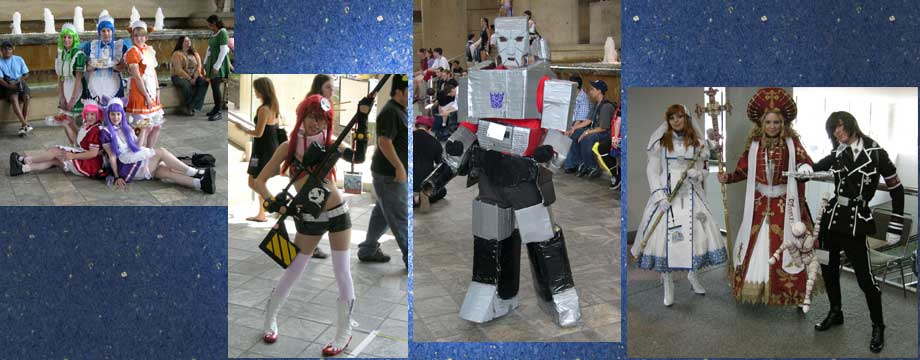How I Learned to Love Otaku, at Otakon

T he first major anime and manga convention in North America took place at the end of August,1991, when AnimeCon was held in San Jose, California. I was then writing a regular column on manga, and in it I wrote that “for four days, nearly two thousand fanatical fans hob-nobbed with each other, bought books, magazines, videotapes, and merchandise, admired each other's costumes, collected autographs, and engaged in marathon sessions of watching Japanese animation.” I had no idea at the time that this would become the basic template for all the subsequent anime conventions which have gradually spread across North America. By 1993, AnimeCon had split into Anime America and Anime Expo, but I attended both that year and later wrote that “Although many women were in attendance at both conventions, the majority of participants still tend to be males, ranging in age from early teens to over forty. Amusingly, many of the Americans proudly refer to themselves as otaku, the Japanese word for somewhat obsessive, semi-autistic anime fans.”
“Otaku,” in Japanese, has a checkered history. It originally was a fairly formal way of saying “you,” or “your house,” but in the 1980s hard core manga and anime fans started using it to address each other in non-formal situations, with the result that it began to take on a life of its own, to become an appellation for the fans themselves. Today, in Japan, the word has morphed into something far broader, for “otaku” can now refer to anyone with a deep, consuming hobby or interest. There are not only manga and anime otaku, but audio otaku, computer otaku, and even military otaku. And due to one particularly disturbing serial murder committed by an otaku in 1988-9, buried deep in the Japanese word there is also a now-fading connotation of deranged, semi-autistic, obsessed, socially inept, dislocated, possibly dangerous young men with pedophiliac tendencies.
When otaku was imported into America, the negative connotations were dropped. It is used here in the same way one might say “fan boy” or “fan girl,” or even “nerd.” What is interesting is that there is no similar word in America to describe fans of French or Mexican comics or animation from other countries—in America “otaku” specifically refers to fans of Japanese manga and animation.
“Otakon,” which cleverly combines the words otaku and conventions, is a pure implementation of the word otaku, in the American sense. I’ve had the pleasure of attending three Otakon conventions now, starting in 1999, and thus watching it grow into one of the premiere conventions in the United States. After attending Otakon ’09 in July of this year, I have to say that it is also one of my favorite cons. It is enormously fun, and quite an inspiration as well—so much so that, while I have never liked the word “otaku” which it incorporates, Otakon 2009 has helped cure me of my lingering allergy to it.

Unlike the first manga/anime conventions in America, which attracted only a few thousand people, today’s Otakon is huge. Over the July 18-20 weekend this year more than 26,000 people are estimated to have attended. In fact, Otakon is so big that it uses the entire Convention Center in Baltimore’s inner harbor area, as well as parts of the next-door Hilton hotel’s facilities, providing a big economic boost to the entire city. Fans come from all over the northeast and the eastern seaboard, and they are no longer mainly males or mainly nerdish fan-boys.
This year, in particular, I was struck by how mainstream anime has become in America, because the audience at Otakon itself is so mainstream. It’s true that most attendees are under sixty, but both genders and all races are now well represented. And the atmosphere is far more peaceful than one might find on the streets. I was continually struck by how well-behaved people were, and by the aura of innocence pervading the giant halls in which people convened to share information on their passion. Were I the parent of a teenager, I certainly would not hesitate to let my children attend Otakon, for most of the teenagers I met comported themselves exceedingly well, and seemed to be having a fabulous time. The world outside may be filled politics, global warming, racial problems, gender strife, drugs and violence, and assorted life-and-death issues like terrorism and war, but inside the halls you would never know it, for Otakon provides a refuge from all that.
In fact, the mainstreaming of anime and manga and the diversification of fandom seems to have had a salubrious effect on cons in general, because the young people in attendance no longer seem so marginalized. Many look like they are the more creative types in high school, or literature or art or drama majors in college, for they are more out-going than fans of the past. And one result is an increase in the number of people wearing costumes. It may be a hallmark of Otakon, but this year I loved watching so many people arriving in costumes (often painstakingly hand-made) and readily posing with kabuki-like panache and style. “Cosplay,” as it is known, is a major part of Otakon, and the big hall Costume Contest is an event not to be missed. As the fan community has accumulated more and more knowledge and experience the level of skill in costume-making and skits performed has improved by leaps and bounds.

Like most anime cons in America, in addition to “cosplay” Otakon features panels of experts on nearly every imaginable and arcane aspect of anime and manga, as well as video screenings of rare and obscure anime shows, artists rooms, a dealer rooms, themed dances, and even anime-themed karaoke events. The panel discussions are a way to share knowledge, and many of them have become very sophisticated over the years, with famous guests from Japan bringing the latest industry news and assorted local experts pontificating on popular shows. But there is also plenty of room for fan-centered panels and for humor. I attended one packed panel titled, “How to Heckle Bad Anime Good,” and the main speaker was so funny and poised that I thought I was in the presence of a professional comedienne.
Unlike Japan, where one of the main features of conventions is the sale of dôjinshi,or fan-created manga, in the United States the center of fan conventions has historically been the dealer’s room, where commercial merchandise is sold. In past years a focal point of dealers’ rooms was always booths selling video tapes, DVDs, and translated manga. As manga and anime have become more and more popular, however, it has become easier for fans to obtain what they want on-line or in bookstores, so there seems to have been a shift to other sorts of harder-to-obtain merchandise. At Otakon 2009 I noticed several vendors in the dealer’s room selling frilly feminine Lolita and Goth-style costumes (all the rage recently in Japanese fandom) to young American women. I was also struck by the sight of at least two large dealer spaces that concentrated on the sale of Japanese language manga. The Boston-based Sasuga bookstore, for example, had a large space jammed with Americans patrons of every color and stripe vying to buy their favorite manga books—in the original untranslated Japanese format. This is surely a product, not only of a fierce interest in manga and anime, but of the diffusion of Japanese-language classes in American high schools and colleges. I was also struck by the sight of more booths selling anime costume paraphernalia, especially fake samurai swords and martial arts weapons.
Lest one worry that these weapons might cause a problem, it is instructive to read the long list of prohibitions prominently posted throughout Otakon halls. Disruptive and offensive behavior, which includes inebriation and the failure to follow rules, quickly results in warnings or expulsion. For costumers, the “weapons” allowed are also strictly regulated. No real swords or knives with sharp edges, or real firearms of any sort, etc., are allowed, but that doesn’t take the fun out of the event. In wandering around the halls one is still likely to run into someone dressed-up as a fantastical anime character holding a scythe or sword or wielding a laser-gun or machine gun, but these weapons will more than likely be obviously constructed of paper-mache, wood, or plastic. They may be quite large. As another regulation generously stipulates, “Prop weapons shall be limited to less than six feet six inches (6'6") in height and less than fifty pounds (50lbs) in weight.”
Having watched the development of these cons over the years, one of the things that I find the most fascinating is the way they are organized. To host a three-day weekend bash for 26,000 people requires huge amounts of money, a mechanism for collecting and managing it, and a way to provide everything from airport pickups for VIPS to convention security. It requires, in other words, hundreds of staff and lots of logistics. The Otakon organization is noted for the fact that it is volunteer-based, but that hardly means it is inefficient. Having attended all sorts of cons over the years, I can say that at most cons glitches are regular and events usually don’t start on time. At Otakon 2009, however, panels proceed according to schedule, with near military precision. Given the size of the event, this is quite a feat to pull off.
One of the main problems that some of the organizers mentioned to me yet again illustrates how thoroughly mainstream and entrenched anime fandom has become in American society. There has been something of a generational split, I was told, for a schism sometimes exists between older fans and newcomers. The older fans had to struggle to get information on the shows they love the most, and they often had to copy and share poor quality video tapes and rely on Japanese friends for translations. Without their efforts to teach others on the attractions of their hobby, moreover, Japanese anime and manga would never have become as popular and available as they are today. Yet today, the old-timers complain, there is a new generation of fans that takes their beloved medium for granted. Many new fans expect to be able to enjoy anime, whether at home or on the web or at conventions, without having to work for it, or without helping to broaden its popularity.
To me, Otakon is a great place to see how new centers of popular culture are emerging in the world, and being blended into something exciting by a new, globalized generation. At one point in history, young Americans were unlikely to look at anything beyond their own borders, but now they are interested in popular culture from Asia, which is in turn inspired by popular culture from America. It is part of an on-going process—of a global mind-meld among youth—that can only help to bring us all together.
© 2009 Frederik L. Schodt
August 10, 2009
San Francisco, California.

